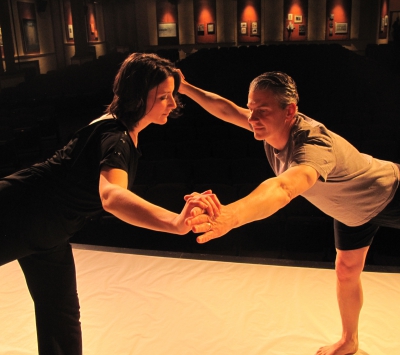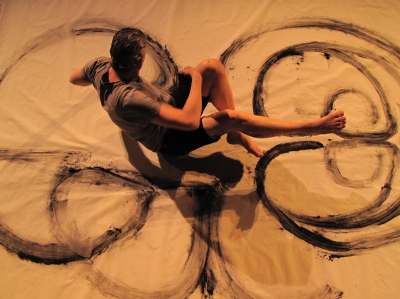
Plenary collaborators Samantha Eagle and Lindel Hart engage in weight sharing, expressive connection, and kinetic forms of communication to illustrate Balance, Nourishment, and Activity: the three pillars of achieving a Whole Life as described by Eagle, who will present “The Well Being: Health, Healing and Community” at the annual Slow Living Summit
Slow Living. It’s the name of annual conference in Brattleboro, the Slow Living Summit, taking place this year June 4-6, presented by Strolling of the Heifers.
And this year, it’s offering a unique and intriguing new format that combines the traditional spoken words of conference presenters with simultaneous interpretive contributions from a variety of artists.
But first, what does Slow Living mean, exactly?
“Slow” embodies the ideals of organizations like Slow Food and Slow Money, along with their accompanying ideas: living sustainably, enjoying the moment, contributing rather than extracting, being mindful, and so many of the ways we live, breathe, think, and feel in an interconnected way.
But the Summit’s organizers say that “Living” is an important part of the Summit’s name, also. “Living” should be mindful and purposeful, but also celebratory and filled with beauty, joy and gratitude. Defining what is meant by living well, or by a life well lived, is as relevant today as it was to the ancients — and as difficult.
Combining these words, “Slow Living” means a more reflective approach to answering how we live, work and play as human beings on a fragile Earth. When we Live Slow, we give back and become more strongly connected to the Earth, to our communities, to our neighbors and to ourselves.
So how might we share these ideas, make connections, build this new story, and engage in a Slow Living culture?
The Slow Living Summit aims to enable participants to drink in these many ideas, ways, and connections. And this year, the organizers want to invite participants to grow into Slow Living not just cerebrally — in a thinking way — but emotionally and spiritually as well — in a “feeling” way.
Orly Munzing (Strolling of the Heifers founder and director) and Linda McInerney (actor and producer who founded Old Deerfield Productions) are friends. They dream together whenever they are together.
McInerney recalled when Munzing told her about her idea for the Summit: “I thought it was an amazing idea. What a great way to build upon expanding this community of folks who have the intention of living sustainably and holistically. I loved the idea.
“But then when I attended the Summit I had to be honest with Orly. The ways that the Summit communicates these amazing ideas only used one channel, that of thought, of the left and logical brain. It seemed that there was much that was being overlooked and that to offer ideas through power point and talking heads was to miss out on deeper communication.
“I felt that a major human element was missing: art. We all are artists and our creativity is a major component of Slow Living.”
Then Munzing had the idea of integrating the arts into the whole conference and she asked McInerney if she would design the conference using the forms of communication that we receive through art. McInerney loved the idea and immediately got to work, calling her artist friends and imagining ways that those friends could enhance the messages of the plenary speakers.
 She worked on creating ways of communicating that were different from the spoken word and dreamed through which art forms might touch different chords of understanding.
She worked on creating ways of communicating that were different from the spoken word and dreamed through which art forms might touch different chords of understanding.
What if Charles Eisenstein gave his plenary while Eugene Friesen improvised themes on his cello in response to his ideas? What if Amy Johnquest painted humor filled cabinet cards expressing the meaning shifting words in Amit Sharma’s Free-co-system plan?
What if guitarist John Sheldon played Yogic melodies while Lindel Hart danced a charcoal body mandala on paper and shared his weight with Samantha Eagle as she offered her healing wisdom? And what if Martin Ping were accompanied by the Hawthorne Valley musicians who grew up in his integrated community?
And what if McInerney shared what it is to creatively collaborate while performing what she created with Terry Jenoure? In addition, the artists will present workshops on the creative process following their plenaries.
When people experience dance, painting, music, poetry, drawing, they have a deep feeling sense of what is expressed. There are many different ways we understand and connect to ideas. We have the classic five senses of touch, sight, hearing, smell, taste, the sixth of intuition and according, to Dr. Dan Siegel, we also have a seventh that is awareness. Art works through multiple senses simultaneously, including the heart and the heart is even smarter than our brain. Our heart actually possesses a heart-brain composed of about 40,000 neurons that can sense, feel, learn and remember.
McInerney says, “The beauty of presenting artists creating on stage with our plenary speakers is this idea of multiple intelligences. And when ideas are expressed in improvisation with the intention of the speaker the information is magnified through feeling. It’s the reason we love to go to a great concert or play. And this year, Summiteers will have the opportunity have that delightful sensory experience while growing as Slow Livers!”
In addition to its collaboratively presented plenary sessions, the Summit offers a diverse list of breakout sessions, including individual sessions by the artists and plenary speakers following up on their presentations. Lunches and receptions feature farm-fresh food and opportunities for Summiteers to make connections. Andhe Summit takes place not in the sterile confines of a hotel conference center, but in various locations in downtown Brattleboro — the Latchis Theatre, the River Garden and Marlboro College Graduate Center — with the town’s lively sidewalks serving as the conference concourse.
For more information, visit the Summit website, http://www.SlowLivingSummit.org.






















































